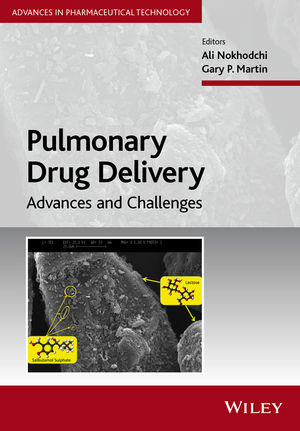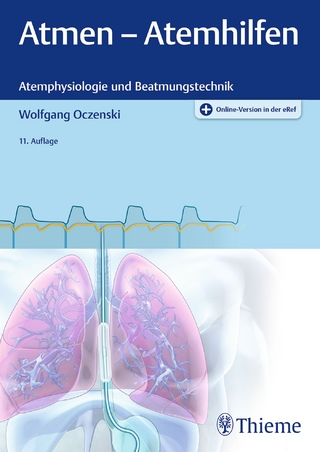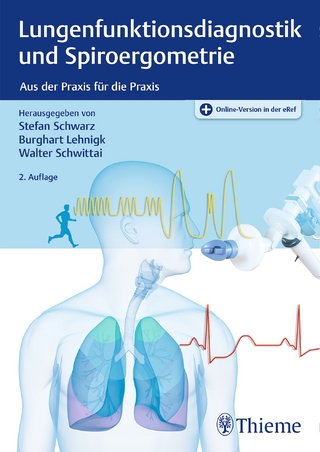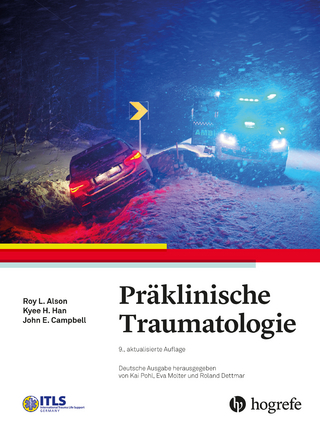
Pulmonary Drug Delivery
John Wiley & Sons Inc (Verlag)
978-1-118-79954-3 (ISBN)
- Titel z.Zt. nicht lieferbar
- Versandkostenfrei innerhalb Deutschlands
- Auch auf Rechnung
- Verfügbarkeit in der Filiale vor Ort prüfen
- Artikel merken
The chapter topics have been selected with a view to integrating the factors that require consideration in the selection and design of device and formulation components which impact upon patient usability and clinical effectiveness. The challenges involved with the delivery of macromolecules by inhalation to both adult and pediatric patients are also covered.
Written by leading international experts from both academia and industry, the book will help readers (formulation design scientists, researchers and post-graduate and specialized undergraduate students) develop a deep understanding of key aspects of inhalation formulations as well as detail ongoing challenges and advances associated with their development.
ALI NOKHODCHI School of Life Sciences, University of Sussex, UK GARY P. MARTIN Institute of Pharmaceutical Science, King’s College London, UK
List of Contributors xiii
Series Preface xvii
Preface xix
1. Lung Anatomy and Physiology and Their Implications for Pulmonary Drug Delivery 1
Rahul K. Verma, Mariam Ibrahim, and Lucila Garcia-Contreras
1.1 Introduction 2
1.2 Anatomy and Physiology of Lungs 2
1.2.1 Macro- and Microstructure of the Airways and Alveoli as It Pertains to Drug Delivery 2
1.2.2 Lung Surfactant 4
1.2.3 Pulmonary Blood Circulation 5
1.3 Mechanisms of Aerosol Deposition 5
1.3.1 Impaction 6
1.3.2 Sedimentation 6
1.3.3 Interception 6
1.3.4 Diffusion 7
1.4 Drug Absorption 7
1.4.1 Mechanisms of Drug Absorption from the Lungs 7
1.5 Physiological Factors Affecting the Therapeutic Effectiveness of Drugs Delivered by the Pulmonary Route 8
1.5.1 Airway Geometry 8
1.5.2 Inhalation Mode 8
1.5.3 Airflow Rate 9
1.5.4 Mechanism of Particle Clearance 9
1.5.5 Lung Receptors 10
1.5.6 Disease States 11
1.5.7 Effect of Age and Gender Difference 11
1.6 Computer Simulations to Describe Aerosol Deposition in Health and Disease 11
1.6.1 Semiempirical Models 12
1.6.2 Deterministic Models 12
1.6.3 Trumpet Models (One-Dimensional) 12
1.6.4 Stochastic, Asymmetric Generation Models 13
1.6.5 Computation Fluid Dynamics (CFD)-Based Model 13
1.7 Conclusions 13
References 14
2. The Role of Functional Lung Imaging in the Improvement of Pulmonary Drug Delivery 19
Andreas Fouras and Stephen Dubsky
2.1 Introduction 19
2.1.1 Particle Deposition 20
2.1.2 Regional Action of Delivered Drug 22
2.1.3 The Role of Functional Lung Imaging in Pulmonary Drug Delivery 22
2.2 Established Functional Lung Imaging Technologies 23
2.2.1 Computed Tomography 23
2.2.2 Ventilation Measurement using 4DCT Registration-based Methods 24
2.2.3 Hyperpolarized Magnetic Resonance Imaging 24
2.2.4 Electrical Impedance Tomography 25
2.2.5 Nuclear Medical Imaging (PET/SPECT) 25
2.3 Emerging Technologies 26
2.3.1 Phase-contrast Imaging 26
2.3.2 Grating Interferometry 27
2.3.3 Propagation-based Phase-contrast Imaging 28
2.3.4 Functional Lung Imaging using Phase Contrast 28
2.3.5 Laboratory Propagation-based Phase-contrast Imaging 29
2.4 Conclusion 30
References 31
3. Dry Powder Inhalation for Pulmonary Delivery: Recent Advances and Continuing Challenges 35
Simone R. Carvalho, Alan B. Watts, Jay I. Peters, and Robert O. Williams III
3.1 Introduction 36
3.2 Dry Powder Inhaler Devices 37
3.2.1 Overview 37
3.2.2 Recent Innovations in Dry Powder Inhaler Technology 39
3.3 New Developments in DPI Formulations and Delivery 43
3.3.1 Particle Surface Modification 43
3.3.2 Particle Engineering Technology for Pulmonary Delivery 44
3.4 Characterization Methods of Dry Powder Inhaler Formulations 50
3.5 Conclusion 52
References 53
4. Pulmonary Drug Delivery to the Pediatric Population – A State-of-the-Art Review 63
Marie-Pierre Flament
4.1 Introduction 63
4.2 Patient Consideration 64
4.2.1 Anatomy and Physiology of Children’s Lungs 64
4.2.2 Nasal Versus Oral Inhalation 65
4.2.3 Patient-related Factors Influencing Aerosol Deposition 66
4.2.4 Age and Dosage Forms of Choice 67
4.3 Delivery Systems for the Pediatric Population 69
4.3.1 Nebulizers 69
4.3.2 Pressurized Metered Dose Inhalers 72
4.3.3 Dry Powder Inhalers 73
4.3.4 Interfaces 74
4.4 Recommendations 80
4.5 Conclusion 82
References 82
5. Formulation Strategies for Pulmonary Delivery of Poorly Soluble Drugs 87
Nathalie Wauthoz and Karim Amighi
5.1 Introduction 88
5.1.1 In vivo Fate of Inhaled Poorly Water-soluble Drugs 89
5.1.2 The Pharmacokinetics of Inhaled Poorly Water-soluble Drugs Administered for Local and Systemic Action 92
5.1.3 Formulation Strategies for Pulmonary Delivery of Poorly Water-soluble Drugs 93
5.2 Co-solvents 93
5.3 Cyclodextrins 97
5.4 PEGylation 99
5.5 Reduction of Size to Micro-/Nanoparticles 100
5.5.1 Nanocrystal Suspension 101
5.5.2 Nanocrystals in a Hydrophilic Matrix System 102
5.5.3 Nanoclusters 103
5.6 Solid Dispersion/Amorphization 103
5.7 Micelles 106
5.8 Liposomes 108
5.9 Solid Lipid Nanoparticles and Nanostructured Lipid Carriers 110
5.10 Conclusion 111
References 114
6. Lipidic Micro- and Nano-Carriers for Pulmonary Drug Delivery – A State-of-the-Art Review 123
Yahya Rahimpour, Hamed Hamishehkar, and Ali Nokhodchi
6.1 Introduction 124
6.2 Pulmonary Drug Delivery 125
6.3 Liposomal Pulmonary Delivery 126
6.4 Nebulization of Liposomes 126
6.5 Liposomal Dry-powder Inhalers 128
6.6 Solid Lipid Microparticles in Pulmonary Drug Delivery 129
6.7 Solid Lipid Nanoparticles in Pulmonary Drug Delivery 131
6.8 Nanostructured Lipid Carrier (NLC) in Pulmonary Drug Delivery 133
6.9 Nanoemulsions in Pulmonary Drug Delivery 134
6.10 Conclusion and Perspectives 135
References 136
7. Chemical and Compositional Characterisation of Lactose as a Carrier in Dry Powder Inhalers 143
Rim Jawad, Gary P. Martin and Paul G. Royall
7.1 Introduction 144
7.2 Production of Lactose 145
7.3 Lactose: Chemical Forms, Solid-State Composition, Physicochemical Properties 147
7.4 Epimerisation of Lactose 150
7.5 Analysis of Lactose 151
7.5.1 Powder X-ray Diffraction 152
7.5.2 Nuclear Magnetic Resonance 153
7.5.3 Infrared Spectroscopy 156
7.5.4 Differential Scanning Calorimetry 157
7.5.5 Polarimetry 158
7.6 The Influence of the Chemical and Solid-State Composition of Lactose Carriers on the Aerosolisation of DPI Formulations 159
7.7 Conclusions 163
References 163
8. Particle Engineering for Improved Pulmonary Drug Delivery Through Dry Powder Inhalers 171
Waseem Kaialy and Ali Nokhodchi
8.1 Introduction 172
8.2 Dry Powder Inhalers 172
8.3 Particle Engineering to Improve the Performance of DPIs 172
8.3.1 Crystallization 173
8.3.2 Spray-drying 174
8.3.3 Spray-freeze-drying 177
8.3.4 Supercritical Fluid Technology 177
8.3.5 Pressure Swing Granulation (PSG) Technique 178
8.4 Engineered Carrier Particles for Improved Pulmonary Drug Delivery from Dry Powder Inhalers 178
8.5 Relationships between Physical Properties of Engineered Particles and Dry Powder Inhaler Performance 182
8.5.1 Particle Size 182
8.5.2 Flow Properties 184
8.5.3 Particle Shape 185
8.5.4 Particle Surface Texture 187
8.5.5 Fine Particle Additives 188
8.5.6 Surface Area 188
8.6 Conclusions 189
References 189
9. Particle Surface Roughness – Its Characterisation and Impact on Dry Powder Inhaler Performance 199
Bernice Mei Jin Tan, Celine Valeria Liew, Lai Wah Chan, and Paul Wan Sia Heng
9.1 Introduction 200
9.2 What is Surface Roughness? 200
9.3 Measurement of Particle Surface Roughness 202
9.3.1 General Factors to Consider During a Measurement 202
9.3.2 Direct Methods to Profile or Visualise Surface Roughness 204
9.3.3 Indirect Measurement of Surface Roughness 206
9.4 Impact of Surface Roughness on Carrier Performance – Theoretical Considerations 206
9.4.1 Mixing and Blend Stability 206
9.4.2 Drug-carrying Capacity 207
9.4.3 Drug Adhesion 207
9.4.4 Drug Detachment 208
9.4.5 Particle Arrangement in Ordered Mixtures After the Addition of Fine Excipient 209
9.5 Particle Surface Modification 210
9.5.1 Spray Drying 210
9.5.2 Solution Phase Processing 211
9.5.3 Crystallisation 213
9.5.4 Sieving 213
9.5.5 Fluid-bed Coating 213
9.5.6 Dry Powder Coating 213
9.6 Conclusion 215
References 215
10. Dissolution: A Critical Performance Characteristic of Inhaled Products? 223
Ben Forbes, Nathalie Hauet Richer, and Francesca Buttini
10.1 Introduction 223
10.2 Dissolution of Inhaled Products 224
10.2.1 Dissolution Rate 224
10.2.2 Dissolution in the Lungs 224
10.2.3 Case for Dissolution Testing 225
10.2.4 Design of Dissolution Test Systems 226
10.3 Particle Testing and Dissolution Media 226
10.3.1 Particle Collection 226
10.3.2 Dissolution Media 229
10.4 Dissolution Test Apparatus 230
10.4.1 USP Apparatus 1 (Basket) 231
10.4.2 USP Apparatus 2 (Paddle) and USP Apparatus 5 (Paddle Over Disc) 232
10.4.3 USP Apparatus 4 (Flow-Through Cell) 232
10.4.4 Diffusion-Controlled Cell Systems (Franz Cell, Transwell, Dialysis) 233
10.4.5 Methodological Considerations 234
10.5 Data Analysis and Interpretation 235
10.5.1 Modelling 236
10.5.2 Comparing Dissolution Profiles (Model-independent Method for Comparison) 237
10.6 Conclusions 237
References 238
11. Drug Delivery Strategies for Pulmonary Administration of Antibiotics 241
Anna Giulia Balducci, Ruggero Bettini, Paolo Colombo, and Francesca Buttini
11.1 Introduction 242
11.2 Antibiotics Used for the Treatment of Pneumoniae 243
11.3 Antibiotic Products for Inhalation Approved on the Market 244
11.4 Nebulisation 246
11.5 Antibiotic Dry Powders for Inhalation 250
11.5.1 Tobramycin 251
11.5.2 Capreomycin 252
11.5.3 Gentamicin 253
11.5.4 Ciprofloxacin 254
11.5.5 Levofloxacin 255
11.5.6 Colistimethate Sodium 256
11.6 Device and Payload of Dose 256
11.7 Conclusions 258
References 258
12. Molecular Targeted Therapy of Lung Cancer: Challenges and Promises 263
Jaleh Barar, Yadollah Omidi, and Mark Gumbleton
12.1 Introduction 265
12.2 An Overview on Lung Cancer 266
12.3 Molecular Features of Lung Cancer 268
12.3.1 Tumor Microenvironment (TME) 269
12.3.2 Tumor Angiogenesis 269
12.3.3 Tumor Stromal Components 270
12.3.4 Pharmacogenetic Markers: Cytochrome P450 270
12.4 Targeted Therapy of Solid Tumors: How and What to Target? 271
12.4.1 EPR Effect: A Rational Approach for Passive Targeting 272
12.4.2 Toward Long Circulating Anticancer Nanomedicines 273
12.4.3 Active/Direct Targeting 273
12.4.4 Overcoming Multidrug Resistance (MDR) 273
12.4.5 Antibody-Mediated Targeting 274
12.4.6 Aptamer-Mediated Targeted Therapy 276
12.4.7 Folate Receptor-Mediated Targeted Therapy 276
12.4.8 Transferrin-Mediated Targeted Therapy 276
12.4.9 Targeted Photodynamic Therapy 277
12.4.10 Multimodal Theranostics and Nanomedicines 278
12.5 Final Remarks 278
References 279
13. Defining and Controlling Blend Evolution in Inhalation Powder Formulations using a Novel Colourimetric Method 285
David Barling, David Morton, and Karen Hapgood
13.1 Introduction 286
13.1.1 Introduction to Blend Pigmentation 287
13.1.2 Previous Work in the Use of Coloured Tracers to Assess Powder Blending 288
13.1.3 Colour Tracer Properties and Approach to Blend Analysis 288
13.2 Uses and Validation 290
13.2.1 Assessment of Mixer Characteristics and Mixer Behaviour 290
13.2.2 Quantification of Content Uniformity and Energy Input 293
13.2.3 Detection and Quantification of Unintentional Milling during Mixing 295
13.2.4 Robustness of Method with Tracer Concentration 295
13.3 Comments on the Applied Suitability and Robustness in of the Tracer Method 296
13.4 Conclusions 297
Acknowledgements 297
References 297
14. Polymer-based Delivery Systems for the Pulmonary Delivery of Biopharmaceuticals 301
Nitesh K. Kunda, Iman M. Alfagih, Imran Y. Saleem, and Gillian A. Hutcheon
14.1 Introduction 302
14.2 Pulmonary Delivery of Macromolecules 302
14.3 Polymeric Delivery Systems 303
14.3.1 Micelles 304
14.3.2 Dendrimers 305
14.3.3 Particles 305
14.4 Preparation of Polymeric Nano/microparticles 305
14.4.1 Emulsification Solvent Evaporation 306
14.4.2 Emulsification Solvent Diffusion 307
14.4.3 Salting Out 307
14.5 Formulation of Nanoparticles as Dry Powders 308
14.5.1 Freeze-drying 308
14.5.2 Spray-drying 309
14.5.3 Spray-freeze-drying 309
14.5.4 Supercritical Fluid Drying 310
14.6 Carrier Properties 310
14.6.1 Size 310
14.6.2 Morphology 311
14.6.3 Surface Properties 311
14.7 Toxicity of Polymeric Delivery Systems 311
14.8 Pulmonary Delivery of Polymeric Particles 312
14.9 Conclusions 313
References 313
15. Quality by Design: Concept for Product Development of Dry-powder Inhalers 321
Al Sayyed Sallam, Sami Nazzal, Hatim S. AlKhatib, and Nabil Darwazeh
15.1 Introduction 322
15.2 Quality Target Product Profile (QTPP) 324
15.3 Critical Quality Attributes (CQA) 324
15.4 Quality Risk Management 325
15.5 Design of Experiments 326
15.6 Design Space 328
15.7 Control Strategies 328
15.8 Continual Improvement 329
15.9 Process Analytical Technology/Application in DPI 329
15.10 Particle Size 329
15.11 Crystallinity and Polymorphism 330
15.12 Scale-up and Blend Homogeneity 331
15.13 Applying of QbD Principles to Analytical Methods 331
15.14 Conclusion 332
References 332
16. Future Patient Requirements on Inhalation Devices: The Balance between Patient, Commercial, Regulatory and Technical Requirements 339
Orest Lastow
16.1 Introduction 340
16.1.1 Inhaled Drug Delivery 340
16.1.2 Patients 340
16.2 Requirements 341
16.2.1 Patient Requirements 341
16.2.2 Technical Requirements 343
16.2.3 Performance Requirements 345
16.3 Requirement Specifications 346
16.3.1 Requirement Hierarchy 346
16.3.2 Developing the Requirements 347
16.4 Product Development 350
16.5 Conclusions 351
References 352
Index 353
| Erscheint lt. Verlag | 3.8.2015 |
|---|---|
| Reihe/Serie | Advances in Pharmaceutical Technology ; 1 |
| Verlagsort | New York |
| Sprache | englisch |
| Maße | 175 x 252 mm |
| Gewicht | 762 g |
| Themenwelt | Medizinische Fachgebiete ► Innere Medizin ► Pneumologie |
| Medizin / Pharmazie ► Medizinische Fachgebiete ► Pharmakologie / Pharmakotherapie | |
| Naturwissenschaften ► Chemie | |
| ISBN-10 | 1-118-79954-2 / 1118799542 |
| ISBN-13 | 978-1-118-79954-3 / 9781118799543 |
| Zustand | Neuware |
| Haben Sie eine Frage zum Produkt? |
aus dem Bereich


